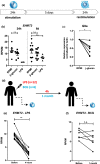Lysine methyltransferase G9a is an important modulator of trained immunity
- PMID: 33708384
- PMCID: PMC7890679
- DOI: 10.1002/cti2.1253
Lysine methyltransferase G9a is an important modulator of trained immunity
Abstract
Objectives: Histone methyltransferase G9a, also known as Euchromatic Histone Lysine Methyltransferase 2 (EHMT2), mediates H3K9 methylation which is associated with transcriptional repression. It possesses immunomodulatory effects and is overexpressed in multiple types of cancer. In this study, we investigated the role of G9a in the induction of trained immunity, a de facto innate immune memory, and its effects in non-muscle-invasive bladder cancer (NMIBC) patients treated with intravesical Bacillus Calmette-Guérin (BCG).
Methods: EHMT2 expression was assessed upon induction of trained immunity by RNA sequencing and Western blotting. G9a inhibitor BIX-01294 was used to investigate the effect on trained immunity responses in vitro. Subsequent cytokine production was measured by ELISA, epigenetic modifications were measured by ChIP-qPCR, Seahorse technology was used to measure metabolic changes, and a luminescence assay was used to measure ROS release. RNA sequencing was performed on BIX-01294-treated monocytes ex vivo.
Results: The expression of EHMT2 mRNA and protein decreased in monocytes during induction of trained immunity. G9a inhibition by BIX-01294 induced trained immunity and amplified trained immunity responses evoked by various microbial ligands in vitro. This was accompanied by decreased H3K9me2 at the promoters of pro-inflammatory genes. G9a inhibition was also associated with amplified ex vivo trained immunity responses in circulating monocytes of NMIBC patients. Additionally, altered RNA expression of inflammatory genes in monocytes of NMIBC patients was observed upon ex vivo G9a inhibition. Furthermore, intravesical BCG therapy decreased H3K9me2 at the promoter of pro-inflammatory genes.
Conclusion: Inhibition of G9a is important in the induction of trained immunity, and G9a may represent a novel therapeutic target in NMIBC patients.
Keywords: BCG; EHMT2; G9a; inflammation; non‐muscle‐invasive bladder cancer; trained immunity.
© 2021 The Authors. Clinical & Translational Immunology published by John Wiley & Sons Australia, Ltd on behalf of Australian and New Zealand Society for Immunology Inc.
Conflict of interest statement
MGN and LABJ are scientific founders of Trained Therapeutics Discovery.
Figures






Similar articles
-
The lysine methyltransferase Ehmt2/G9a is dispensable for skeletal muscle development and regeneration.Skelet Muscle. 2016 May 27;6:22. doi: 10.1186/s13395-016-0093-7. eCollection 2016. Skelet Muscle. 2016. PMID: 27239264 Free PMC article.
-
Inhibition of EHMT2/G9a epigenetically increases the transcription of Beclin-1 via an increase in ROS and activation of NF-κB.Oncotarget. 2016 Jun 28;7(26):39796-39808. doi: 10.18632/oncotarget.9290. Oncotarget. 2016. PMID: 27174920 Free PMC article.
-
Histone lysine methyltransferase G9a is a novel epigenetic target for the treatment of hepatocellular carcinoma.Oncotarget. 2017 Mar 28;8(13):21315-21326. doi: 10.18632/oncotarget.15528. Oncotarget. 2017. PMID: 28423509 Free PMC article.
-
Targeting EHMT2/ G9a for cancer therapy: Progress and perspective.Eur J Pharmacol. 2021 Feb 15;893:173827. doi: 10.1016/j.ejphar.2020.173827. Epub 2020 Dec 19. Eur J Pharmacol. 2021. PMID: 33347828
-
The Lysine Methyltransferase G9a in Immune Cell Differentiation and Function.Front Immunol. 2017 Apr 11;8:429. doi: 10.3389/fimmu.2017.00429. eCollection 2017. Front Immunol. 2017. PMID: 28443098 Free PMC article. Review.
Cited by
-
BCG Vaccination Potentially Modulates the Transcriptome of Infant CD4 T Cells in Addition to Age-Dependent Immune Ontogeny-Associated Changes.Vaccines (Basel). 2025 Jun 29;13(7):706. doi: 10.3390/vaccines13070706. Vaccines (Basel). 2025. PMID: 40733683 Free PMC article.
-
Innate immune memory in cardiometabolic disease.Cardiovasc Res. 2024 Feb 17;119(18):2774-2786. doi: 10.1093/cvr/cvad030. Cardiovasc Res. 2024. PMID: 36795085 Free PMC article. Review.
-
EHMT2 affects microglia polarization and aggravates neuronal damage and inflammatory response via regulating HMOX1.Transl Neurosci. 2023 Jul 27;14(1):20220276. doi: 10.1515/tnsci-2022-0276. eCollection 2023 Jan 1. Transl Neurosci. 2023. PMID: 37529171 Free PMC article.
-
Neuroprotective effects of G9a inhibition through modulation of peroxisome-proliferator activator receptor gamma-dependent pathways by miR-128.Neural Regen Res. 2024 Nov 1;19(11):2532-2542. doi: 10.4103/1673-5374.393102. Epub 2024 Jan 8. Neural Regen Res. 2024. PMID: 38526289 Free PMC article.
-
Setdb2 Regulates Inflammatory Trigger-Induced Trained Immunity of Macrophages Through Two Different Epigenetic Mechanisms.Res Sq [Preprint]. 2025 May 28:rs.3.rs-6702384. doi: 10.21203/rs.3.rs-6702384/v1. Res Sq. 2025. PMID: 40502770 Free PMC article. Preprint.
References
-
- Netea MG, Quintin J, van der Meer JW. Trained immunity: a memory for innate host defense. Cell Host Microbe 2011; 9: 355–361. - PubMed
LinkOut - more resources
Full Text Sources
Other Literature Sources
